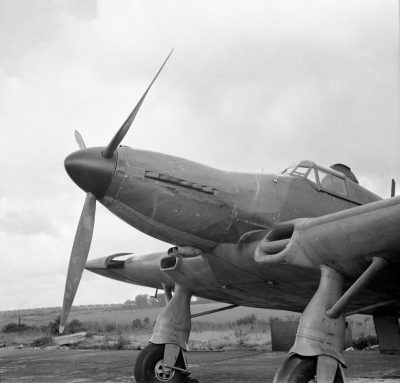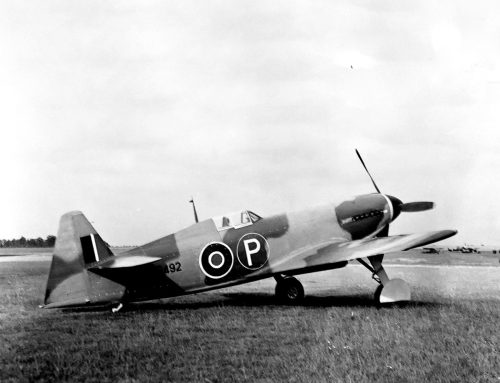When the Hawker Typhoon aircraft was being developed Sidney Camm and his team had to find a way to efficiently cool the Napier Sabre engine. Overheating had plagued the Sabre throughout the engine’s development until the engine design ‘challenges’, so very public in a time of war, were solved. With a dry weight over one ton; the powerful Napier Sabre engine was a really big lump of metal to keep cool . Hawker’s solution was to locate the cooling radiator below the engine and scoop large amounts of air by ducting it through a large intake that gave the Typhoon and later Tempest the appearance of having a very pronounced chin! This gave these aircraft their most recognisable feature and ensured a sufficient flow of air to cool the massive and powerful engine.
In the latter years of the War Napier’s Flight Test Development Establishment in Luton worked on developing new and better radiator formats in order to improve engine cooling as power increased, reducing drag and reducing vulnerability in combat. The Luton F.D.E. worked on a series of annular radiator designs – follow link for further details.
The image below shows the front section of a Hawker Tempest aircraft with an experimental exhaust and the aircraft fitted with the momentum air filter which was so successful during the Normandy Beach landings. You can clearly see the impressive profile of the radiator housing.
Was the chin radiator fitted to the Hawker Typhoon and Hawker Tempest Aircraft dangerous?
It has often been a misconception that the chin radiator fitted to the Hawker Tempest and Typhoon aircraft could cause ‘terminal’ accidents if the aircraft was forced to make an emergency landing in water, or land after an undercarriage failure. The chin radiator was a relatively fragile piece of equipment when compared to the Sabre’s dense engine block. In the event of an emergency ditching or belly landing the radiator assembly would simply be no match to the sheer inertia of a 5 ton aeroplane. The reputation for poor ditching characteristics (often a fatal ‘dead stop’) shown by the Typhoon was due to its ‘thick profile’ wing. This was a fault shared with the Hurricane which, of course, did not have a chin radiator, but was absent from the Tempest with its ‘thin profile’ wing whilst utilising the Sabre chin radiator.
Napier Luton’s Flight Development Establishment worked hard to improve the cooling and aerodynamic characteristics of the Hawker Tempest. This research work resulted in the development of annular radiator designs being fitted to several aircraft. You can read more about these Sabre annular radiators by following this LINK.
Whilst the Tempest and Typhoon featured this chin radiator design other aircraft did not including the only other production aircraft fitted with the Sabre – the Blackburn Firebrand II. Similarly the host of Sabre fitted prototype and test-bed aircraft including Fairly Battle, Holland Fo.108, Hawker Fury, Martin Baker MB3, Vickers Warwick, the famous Napier- Heston Racer were chinless wonders!
These interesting images below show the Folland Fo.108 radiator intake this efflux from the Heston Racer’s radiator.










